At 14,000 ft, Ladakhi Man’s Organic Self-Sustaining Farm Earns Him Lakhs
Besides growing 20 varieties of crops ranging from barley to watermelons, this 'Mitti Ka Aadmi' also extracts pashmina from his cashmere goats, teaches organic farming techniques while also running an independent homestay in Ladakh.
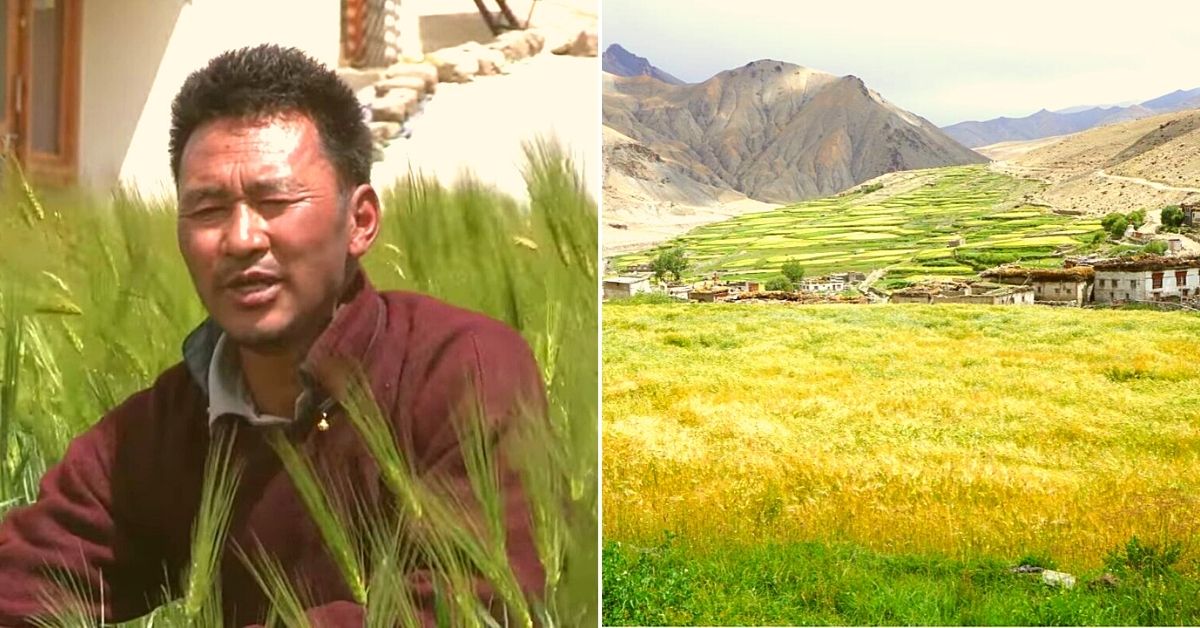
For Urgain Phuntsog, a 48-year-old resident of Gya village, which is located approximately 70 km from Leh and perched at an altitude of nearly 14,000 feet above sea level, farming is pretty much all he has known. Losing his father at the age of 12, the organic farmer’s childhood memories are replete with stories of helping his mother collect mountain shrubs or dry dung for heating or cooking, among other chores. His younger brother, Stanzin Dorjai is an award-winning documentary filmmaker, and elder sister, Tsering (53), meanwhile would take care of the family livestock, which include cashmere goats, sheeps and yaks, out to graze on higher ground.
“My father passed away when I was barely 12 years old, and I had no choice but to quickly learn ploughing, sowing, grinding flour and making irrigation channels as a young boy. Of course, starting out I would struggle with these tasks, but back then other residents of the village didn’t mind showing me the ropes. On the family farm, we would grow mustard, potatoes, peas and barley, but our main source of income and sustenance, particularly during the winters, was our livestock. The fondest memories I have of my childhood is working in the fields,” Urgain tells The Better India.
Like many youngsters of his generation, Urgain, who had finished high school, harboured aspirations of leaving his village and obtaining a government job. There were opportunities of enlisting in the Indo-Tibetan Border Police (ITBP) and he even applied to the Indian Navy. But with his mother suffering from a serious knee-related condition, Urgain had little choice but to assist her in maintaining the family farm.
“I realised that there was no one to look after my family and it was hopeless to expect a government job considering the circumstances of my family. My sister, Tsering, who decided to forego marriage and take care of our livestock, said that it would be a matter of shame if we didn’t work together to hold onto the land our ancestors left behind,” says Urgain.
Today, Urgain owns about 31 kanals of land, but cultivates about 62 kanals that also includes the share of his younger brother. “Urgain Phuntsog, popularly known as ‘Mitti Ka Aadmi’ in the village, has been successfully following an integrated farming system approach. At a height of 14,000 feet, where it is difficult for even human beings to survive, he is producing different vegetables, growing cereals like barley, raising livestock, cultivating mushrooms, rearing sheep and goats and producing vermicompost from his farm, animal and household waste,” noted a 2019 paper published in the International Journal of Current Microbiology and Applied Sciences.
“A key feature of his farming system is that he uses the output of one component as input of another component thereby reducing his cost of cultivation and raising his income,” it adds.
“The name Mitti Ka Aadmi (man of the soil), which my fellow villagers have given me comes from my obsession with farming. They say I am too engaged with farming since there is soil on my clothes all the time. Even my sisters scold me saying that I spend too much time alone working with soil, which they argue will reduce my lifespan,” he laughs.
Diversifying organically
Urgain’s eyes were opened to the possibilities of growing a variety of crops back in March 2010 when the local agriculture department in collaboration with the horticulture department organised a 10-day exposure tour for a select group of Ladakhi farmers.
“They took us to agricultural universities in Srinagar, Jammu and Pusa, where they exposed us to growing new crops on our farms and novel methods of farming. It was quite an insightful trip. Earlier, I would cultivate barley or potato without much thought. After visiting these institutions, I began cultivating new crops using a greenhouse,” he recalls.
Urgain began with growing cauliflowers and cabbage, before progressing to quinoa, corn, fennel seeds and garlic. Seeds for certain crops were procured from friends visiting Ladakh. Today, he grows about 20 varieties of crops including kidney beans, broccoli, cauliflower, cabbage, onion, fennel seeds, garlic, four varieties of radish, turnip, potato, pea, cucumber, lettuce, strawberries and even watermelons.

Earning from cultivation and milching cattle
In terms of cereals, he primarily grows barley and wheat. In a season (four months), he earns a yield of about 35.7 quintals over 42 kanals of land (85 kg per kanal). He sells his wheat for Rs 50 per kg in parts of Ladakh including Demchok and Kharnak in the Changthang area. He also sells wheat in the Sheynam and Tukcha area in Leh.
Most of his vegetables are grown in his two greenhouses measuring 32×16 feet and 100×25 feet, which are used intensively during winter. Since he produces his own seed for almost every vegetable, the cost of cultivation is limited to labour costs involved in the preparation of beds, weeding, and in transportation. The entire exercise requires about 12 man days at Rs 600 per labourer including other expenses.
“Leaving aside all expenses, I earn around Rs 1,20,000 per season on all crops,” he claims.
When it comes to livestock, the cashmere goats and sheeps are a great source of pashmina and wool. From a single goat, he extracts about 150 gm of Pashmina and about 1.7 kg of fleece is obtained from each sheep. In total, his goats produce about 20 kg of pashmina. In total he earns about Rs 27,000 from the sale of pashmina and fleece in any given season.
Meanwhile, he also earns a net income of Rs 80,700 over nine months from his milching cattle.
Besides, his family assists him in making traditional dresses like the Goncha, caps, gloves and other accessories, which fetches him additional income, not to mention that he also makes his own bread. This is served to foreign tourists residing in local village home stays.
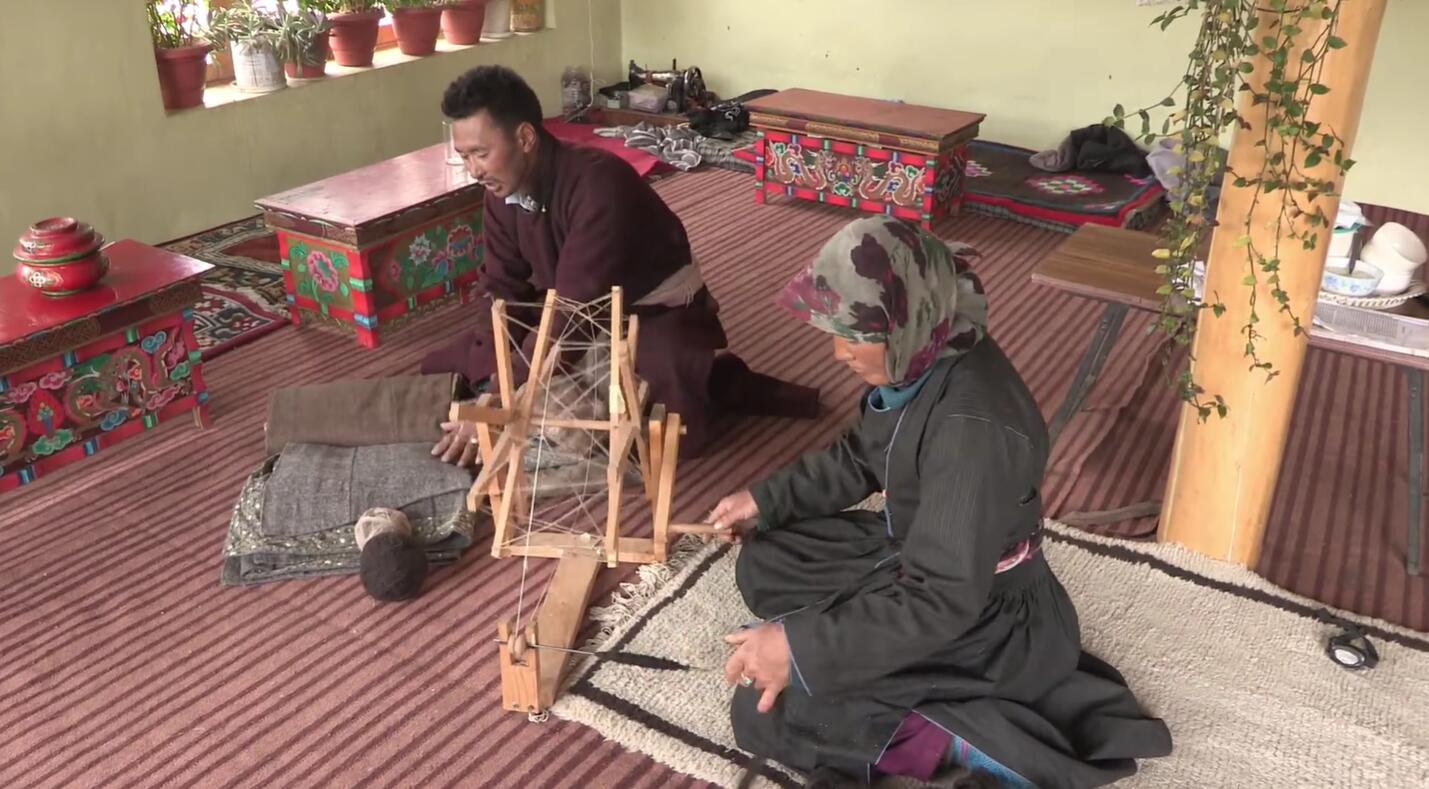
“I have also made a tiny homestay, where I train or host people interested in organic agriculture. It runs throughout the year and it gives me enough income for sustenance. Every year about 200-250 people, including students, come to learn about different facets of organic farming from me,” he claims.
“Urgain is even growing crops like tomatoes and watermelons in such conditions. He has majorly employed the mulching technology, which allows him to grow such crops. Also, as a result of the cold climate, the farming season in villages like Gya starts later and ends sooner by around 15 days or so, thus giving them a shorter window. However, he overcomes that challenge using traditional farming methods alongside modern innovations like mulching, greenhouses and vermicomposting,” notes Dr Tsering Stobdan, an agricultural scientist responsible for introducing key innovations to Ladakhi farmers.
(Check out our detailed explainer on how black plastic mulching is helping farmers in Ladakh)
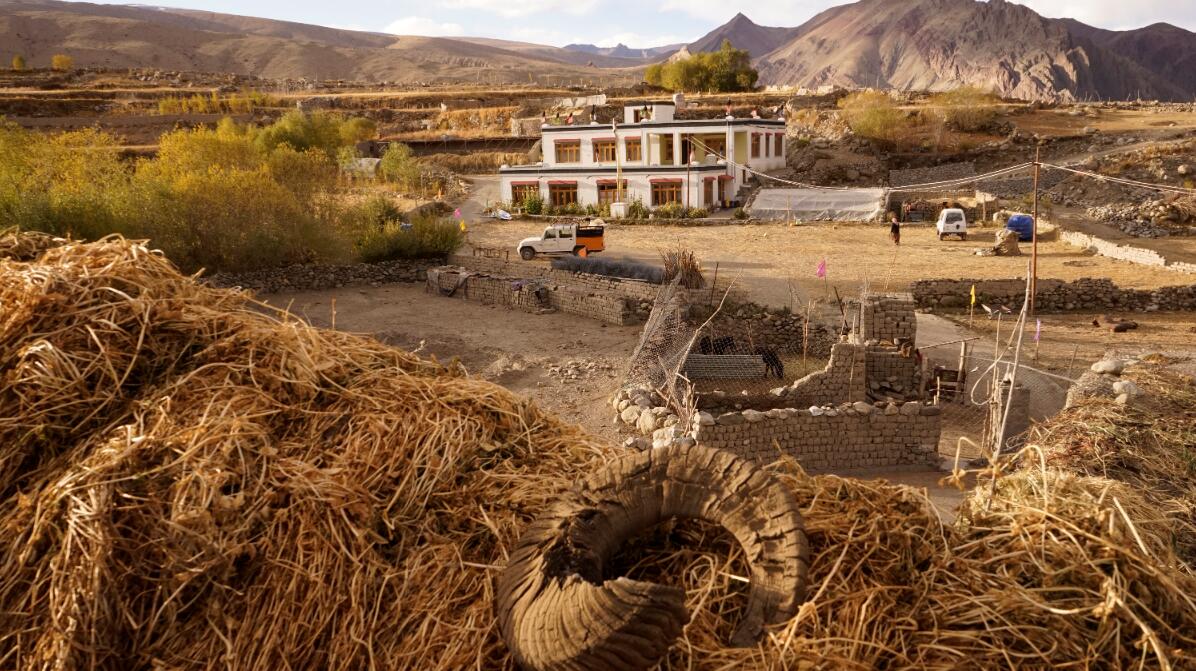
A dedication to organic farming
Urgain’s family claims to have never used chemical fertilizers or pesticides subsidised by the government. It’s a practice he has continued, although the difference with his farm is the generation and usage of vermicompost. All the animal waste and farm waste are recycled through earthworms to produce vermicompost.
“As of today, we have 306 livestock animals with a majority of them being goats. We have about five milk giving cows and eight other bovines which includes dzos (a yak-cow cross breed). We also own eight horses,” he recalls.

He currently has about 1200 bags (each bag measuring 50 kg) of manure. He never uses cattle or horse dung like firewood for heating or cooking. Instead, he collects manure, and leaves it rotting for a year. “I had heard from the TV and radio programmes that using organic manure leads to healthier crops and lessens the chances of falling prey to diseases. But we need to let it rot for a year before using it on the field or vegetable garden. I have been practicing it for six to seven years now. However, despite having ample manure, I use vermicompost manure,” he notes.
He began practicing vermicomposting about two years ago, when he bought kilos of earthworms from Krishi Vigyan Kendra (KVK), Leh. When it worked out well on cattle manure, he used horse dung. When that worked out well too, the following year saw Urgain using it on pulverized cattle dung (locally called ldur), which is of a slightly stronger variety.
“Today, I cultivate my own earthworms. This year, my yield was 500 kg. Usually, the selling price of earthworms is Rs 600 per kilo in Ladakh. Thinking about other farmers like me, I sold these worms to the agriculture department and KVK at a discounted price of Rs 300. In addition to organic manure, we use farm waste, kitchen waste, fallen leaves of poplar, etc,” Urgain says.
Dr Stobdan adds, “Maintaining those worms during peak winters is very challenging and he is able to keep them alive even during peak winters. Another impressive facet of his farm is how he has diversified into growing cash crops like mushrooms as well.”
Besides employing natural fertilizers and vermicomposting, Urgain uses a combination including a solution of stinging nettle and locally found wild herbs as insecticides.
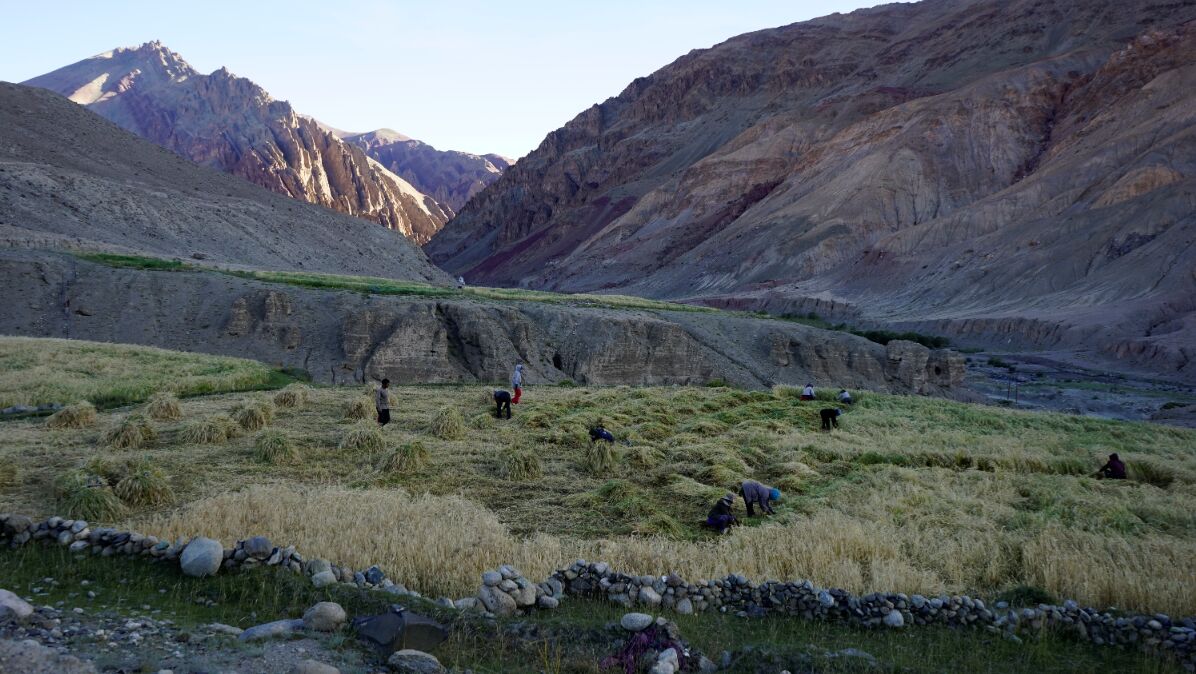
When farming at 14,000 ft…
The challenges of growing crops at this altitude is very real with winter temperatures dipping to -30º C and winds blowing at around 25 kmph. These conditions particularly impact the polythene sheets used in the greenhouses. These sheets (costing about Rs 12,000-13,000 each) suffer regular wear and tear and replacing them regularly isn’t easy.
“Our place is very windy and temperatures fall precipitously. To assist the polythene sheets, I visit second hand stores, buy clothes in big sizes, sew them together as a blanket and put them in the greenhouse. I remove them for a while after an hour of sunrise and cover them an hour before sunset on them with stones to maintain temperature levels inside. During snowfall, they slip and sometimes tear the plastic sheets as well,” he notes.
“Also, due to the altitude and cold, the chances of a pest invasion is very low. We have a systematic water distribution system for irrigation for equitable distribution. A major challenge is that during spring, we have a shortage of water due to slow snow melting. In autumn or summer, when the weather gets hot we have too much water,” he adds.
Moreover, with little access to markets outside Ladakh and limited markets within, selling his produce has proven to be a real challenge. He recalls an instance a couple of years ago, when he wanted to sell 200 kg of cauliflower.
“Sellers in the Leh area said that they can pay me only Rs 25 per kg despite telling them that I have grown it organically. They were bargaining it for Rs. 20 per kg. When I asked them how much they charge, they told me Rs.60 per kg.
Unhappy, I brought them back and offered it to monasteries and cooperatives or dried them up for the winter season,” he laments, adding, “Many are ignorant about what it takes to grow food in a topographically harsh place like Ladakh.
Another concern is the growing mechanisation of farming in Ladakh, particularly the use of tractors which he considers a ‘necessary evil’.
“But we must recognise Urgain’s self-sustained organic farm, how he employs innovative farm techniques and markets his produce in remote corners of Ladakh like Changthang. More importantly, he trains his fellow villagers in his organic farming techniques and facilitates exposure tours to Leh and the surrounding areas where such progressive farming practices have been taken up,” notes Dr. Stobdan.
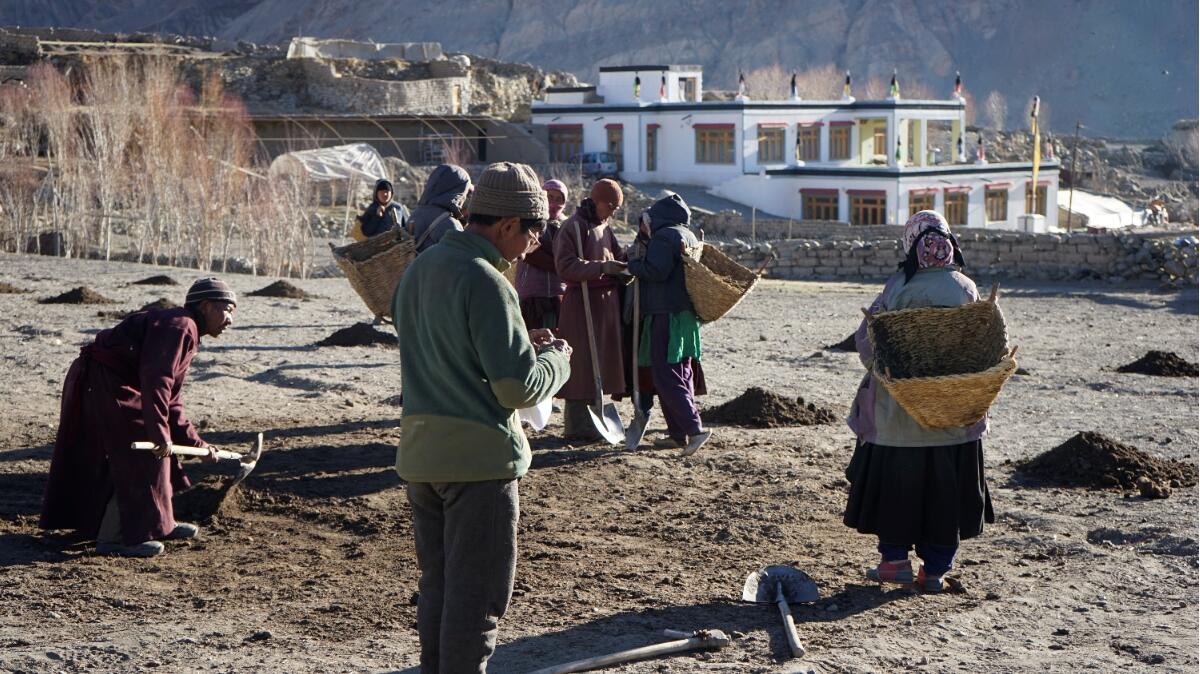
‘Leaving our land useless is a sin’
“It takes a lot of patience to see something grow and yield well. The best thing about farming is becoming self-sufficient in terms of food without having to ask anyone. That was proven well this year during the COVID-19 induced lockdown. I have wheat, mustard, and various vegetables and dried them for winter consumption. With sufficient food at home, I donated some vegetables to my neighbours who didn’t have enough. In the event of a natural calamity or lack of road connectivity, we don’t have to put our hands out to anyone,” he says.
However, he argued that none of this would have been possible without his family, particularly his younger brother Stanzin, sister Tsering and his wife, Chamba Dolkar.
“People tell me that continuous use of chemical fertilizers and pesticides has made our farmland more vulnerable to the vagaries of nature. We only live for a certain amount of years and leaving our land useless for future generations is a sin. We must go organic. Being religious means nothing if we cannot help future generations,” he says.
(With key inputs from Namgail Angmo)
(Edited by Yoshita Rao)
Like this story? Or have something to share? Write to us: [email protected], or connect with us on Facebook and Twitter.
If you found our stories insightful, informative, or even just enjoyable, we invite you to consider making a voluntary payment to support the work we do at The Better India. Your contribution helps us continue producing quality content that educates, inspires, and drives positive change.
Choose one of the payment options below for your contribution-
By paying for the stories you value, you directly contribute to sustaining our efforts focused on making a difference in the world. Together, let’s ensure that impactful stories continue to be told and shared, enriching lives and communities alike.
Thank you for your support. Here are some frequently asked questions you might find helpful to know why you are contributing?


This story made me
-
97
-
121
-
89
-
167













